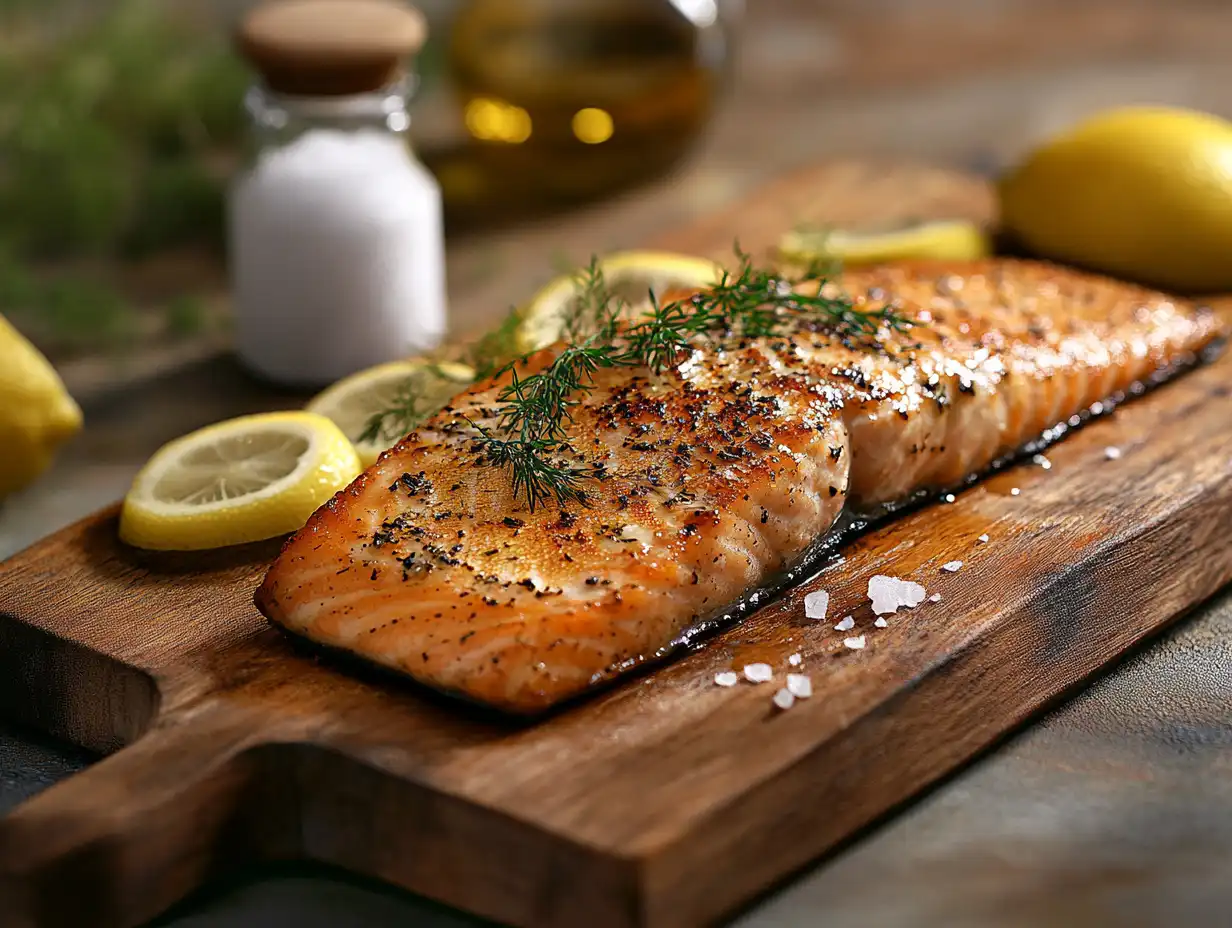what is the best method of cooking trout ?Trout is one of those versatile fish that can be transformed into a culinary masterpiece. Whether you’re a seasoned chef or a beginner, cooking trout offers endless possibilities to enhance your flavors. But what’s the best method for preparing this delicious fish? The answer depends on your taste, mood, and cooking equipment. From smoky grilled fillets to delicate poached dishes, there’s a cooking technique to suit every palate.
Table of Contents
Introduction to Cooking Trout
Cooking trout is as versatile as painting a masterpiece. With its mild, delicate flavor, trout pairs well with a wide range of spices, herbs, and cooking techniques. But more importantly, it’s easy to cook, making it a great choice for weekday dinners and fancy weekend feasts.
When cooking trout, the goal is to enhance its natural flavor without overpowering it. Choosing the right method is key to creating a dish that’s flavorful and memorable.
Understanding Trout: A Culinary Delight
Types of Trout Commonly Used in Cooking
Not all trout are created equal, and knowing the type you’re working with can elevate your dish. Rainbow trout, for instance, is mild and tender perfect for baking or grilling. Brown trout has a richer, earthier flavor, making it ideal for hearty recipes. Then there’s brook trout, smaller and more delicate, often enjoyed pan-fried for a quick, satisfying meal. For a deeper dive into trout varieties, check out What’s the Difference Between a Rainbow Trout and a Steelhead?.
Nutritional Benefits of Eating Trout
Trout is not just delicious; it’s a powerhouse of nutrition. Loaded with omega-3 fatty acids, high-quality protein, and essential vitamins like B12 and D, trout contributes to heart health, brain function, and overall well-being. Plus, it’s low in calories, so you can indulge guilt-free.
“Trout is like nature’s gift—a balance of flavor and nutrition in every bite.”
Preparing Trout for Cooking
Before you even think about turning on the stove, preparation is crucial. Proper preparation ensures your trout cooks evenly and tastes incredible.
How to Choose Fresh Trout
The first rule of thumb: freshness is everything. Look for trout with bright, clear eyes and shiny, tight skin. It should have a fresh, clean smell anything too fishy is a no-go. If you’re buying fillets, ensure they’re firm and moist with no discoloration.
Cleaning and Gutting Trout Effectively
If you’re working with whole trout, cleaning is the first step. Start by rinsing the fish under cold water. Using a sharp knife, make a slit from the belly to the tail and carefully remove the guts. Rinse again, paying extra attention to the cavity. Voilà your trout is ready for seasoning!
Marinating and Seasoning Trout for Flavor
Seasoning can make or break your trout dish. Simple combinations like salt, pepper, and a squeeze of lemon work wonders. Want to elevate the flavor? Try marinating the fish in olive oil, garlic, and fresh herbs like thyme or dill for an hour before cooking. The result is a flavor explosion that enhances the natural taste of the fish.
“Think of marinating trout as adding a melody to a beautiful song it’s all about balance and harmony.”
Exploring Cooking Methods for Trout
There’s no one-size-fits-all when it comes to cooking trout. Each method has its charm, so don’t be afraid to experiment.
Grilling Trout: A Smoky Delight
Grilling trout is perfect for summer barbecues. Brush the fish with oil, season it, and place it on a hot grill. You’ll get crispy skin and a smoky flavor that’s hard to beat. Pro tip: Use a grill basket to prevent the fish from sticking.
Baking Trout: A Healthy Option
Baking trout is as simple as it gets. Lay the fish on a baking tray, drizzle with olive oil, and season with herbs. Pop it into a preheated oven (around 375°F) for 15-20 minutes. Baking locks in moisture, making it a healthy and fuss-free choice.
Pan-Frying Trout: A Quick and Crispy Method
When time is short, pan-frying is your best friend. Heat some butter or oil in a pan, season the trout fillets, and cook for about 3-4 minutes per side. The result? Golden, crispy skin with tender, juicy flesh inside.
Poaching Trout: A Gentle Approach
For a delicate, melt-in-your-mouth experience, try poaching. Simmer the fish in broth or water flavored with herbs, lemon, and wine. This method keeps the fish incredibly moist while enhancing its subtle flavors.
Smoking Trout: Unlocking Deep Flavors
Smoking trout requires a bit of patience but rewards you with bold, complex flavors. Use a smoker or stovetop method, and let the fish absorb the smoky aroma. Smoked trout is excellent for salads, sandwiches, or just enjoyed on its own.For inspiration, check out this Steelhead Trout Recipe for more ideas.
Tips for Perfectly Cooked Trout
Cooking trout to perfection takes a bit of finesse, but these tips will set you up for success.
Temperature and Timing Recommendations
Overcooking trout is a common pitfall. Aim for an internal temperature of 145°F and remember: trout cooks quickly! A general rule is 8-10 minutes per inch of thickness.
Common Mistakes to Avoid When Cooking Trout
One of the biggest mistakes is over-seasoning—trout’s flavor is delicate and can easily be overshadowed. Another is cooking it too long, which leads to dry, chewy fish. Always monitor your trout closely for the best results.
Pairing Trout with Sides and Beverages
The beauty of trout lies in its versatility it’s like a blank canvas waiting for the perfect sides and beverages to complete the picture. Pairing your trout dish thoughtfully can turn a good meal into a memorable dining experience.
Best Side Dishes to Serve with Trout
When deciding on sides, think of flavors and textures that complement trout’s delicate taste. Here are some excellent choices:
- Roasted Vegetables: Earthy veggies like asparagus, zucchini, or Brussels sprouts bring out the natural sweetness of trout.
- Lemon Herb Rice: A fragrant, zesty side balances the fish’s richness.
- Creamy Mashed Potatoes: The buttery, velvety texture pairs beautifully with grilled or pan-fried trout.
- Crispy Salads: A refreshing salad with arugula, spinach, or kale and a citrus vinaigrette adds a delightful crunch.
Beverage Pairings for Trout Dishes
Pairing the right drink with trout can elevate the dish to gourmet levels. Here are some pairing tips:
- Non-Alcoholic Options: Sparkling water with lemon or an herbal iced tea is a refreshing choice for non-drinkers.
“Pairing trout with the right sides and drinks is like setting the perfect background to highlight a star performer.”
If you’re curious about similar dishes, read more at Is Steelhead Trout Better for You than Salmon?.
Regional and International Recipes for Trout
Trout may feel like a humble fish, but it holds a prominent place in kitchens around the world. Exploring its international preparations opens the door to unique flavors and techniques.

Classic American-Style Grilled Trout
This recipe is all about simplicity. Coat the fish with olive oil, sprinkle salt and pepper, and grill it to perfection. Add a squeeze of lemon before serving for a truly classic experience.
European-Inspired Trout Recipes
- French Almondine: Pan-fried trout fillets topped with toasted almonds and browned butter create a luxurious dish.
- Italian Trout Piccata: Cook trout with white wine, capers, and a hint of garlic for a Mediterranean twist.
Asian-Style Trout Dishes
In Asia, trout often gets bold, umami-rich flavors:
- Teriyaki Trout: Marinate trout in soy sauce, honey, and ginger, then grill or bake for a sweet-savory delight.
- Thai Trout Curry: Cook trout in a spicy coconut curry with lime and cilantro for a dish that’s bursting with flavor.
Addressing Common Problems in Cooking Trout
Even the best cooks face challenges when working with trout. Here’s how to tackle some of the most common issues.
How to Prevent Trout from Sticking to the Pan
Sticky fish can ruin your day and your dinner. To avoid this:
- Make sure the pan is hot before adding the fish.
- Use enough oil or butter to create a non-stick surface.
- Pat the trout dry with a paper towel before cooking to reduce moisture.
Solutions for Overcooked or Undercooked Trout
Overcooking trout can turn it rubbery, while undercooking might make it unsafe to eat. Here’s how to avoid both:
- Use a meat thermometer to ensure the internal temperature reaches 145°F.
- Keep an eye on the clock trout cooks quickly, so don’t leave it unattended.
- If you accidentally overcook the fish, a drizzle of olive oil or a squeeze of lemon can help revive its moisture.
“Cooking is a journey, and every mistake is a lesson in disguise. Trout just happens to be a delicious teacher.”
Key Takeaways for Cooking Trout
Cooking trout is an art that blends preparation, technique, and creativity. Whether you’re grilling for a smoky kick, baking for a healthy touch, or pan-frying for crispy goodness, each method has its unique charm.
Encouragement to Experiment with Different Methods
Don’t be afraid to experiment. Try marinating with new spices, pairing trout with unexpected sides, or exploring international recipes. Cooking is about making the dish your own, so embrace the process and have fun!
“Cooking trout isn’t just about food—it’s about creating moments, exploring flavors, and sharing joy with those around you.”
Frequently Asked Questions about Cooking Trout
To wrap things up, let’s tackle some common questions that people often have when cooking trout. Whether you’re a beginner or a seasoned home chef, these answers should help you make the most out of your trout cooking experience.
What is the best way to cook trout for beginners?
For beginners, baking is often the easiest and most foolproof method. Simply season the trout, place it on a baking sheet, and cook in a preheated oven at 375°F for about 15-20 minutes. It’s a low-maintenance way to get delicious results without much effort.
How do you know when trout is fully cooked?
Trout is fully cooked when the flesh turns opaque and flakes easily with a fork. Using a meat thermometer is a great way to ensure accuracy the internal temperature should reach 145°F.
Can you eat the skin of trout?
Absolutely! Trout skin is not only edible but also delicious when cooked properly. Grilling or pan-frying can make the skin crispy and flavorful. Just make sure the fish is scaled before cooking.For tips on preparation, visit Do You Eat the Skin on Steelhead Trout?.
How do you store leftover cooked trout?
Store cooked trout in an airtight container in the refrigerator for up to three days. If you want to keep it longer, consider freezing it. To reheat, use a low oven or microwave to maintain the fish’s texture and moisture.
Is it necessary to marinate trout before cooking?
Marinating is not necessary, but it can enhance the flavor. Simple marinades with lemon juice, olive oil, and herbs work well. If you’re short on time, seasoning with salt, pepper, and fresh herbs can also yield great results.
What are some common mistakes when cooking trout?
Overcooking is the most common mistake, leading to dry and rubbery fish. Another frequent error is using too much seasoning, which can overpower the trout’s delicate flavor. Always aim for balance and monitor cooking times closely.
Conclusion: Trout Cooking Made Simple
Cooking trout doesn’t have to be intimidating. With the right preparation, techniques, and a touch of creativity, you can transform this humble fish into a culinary masterpiece. From smoky grilled fillets to savory Asian-inspired dishes, trout’s versatility ensures that there’s a method to suit every taste and occasion.
As you experiment with different cooking styles, remember that cooking is as much about joy and exploration as it is about technique. Don’t hesitate to try new recipes or tweak the classics to match your preferences. Whether you’re serving trout to family, friends, or just treating yourself, the process is as rewarding as the meal itself.
“Cooking trout is like a journey the destination is delicious, but the real magic lies in the adventure.”

